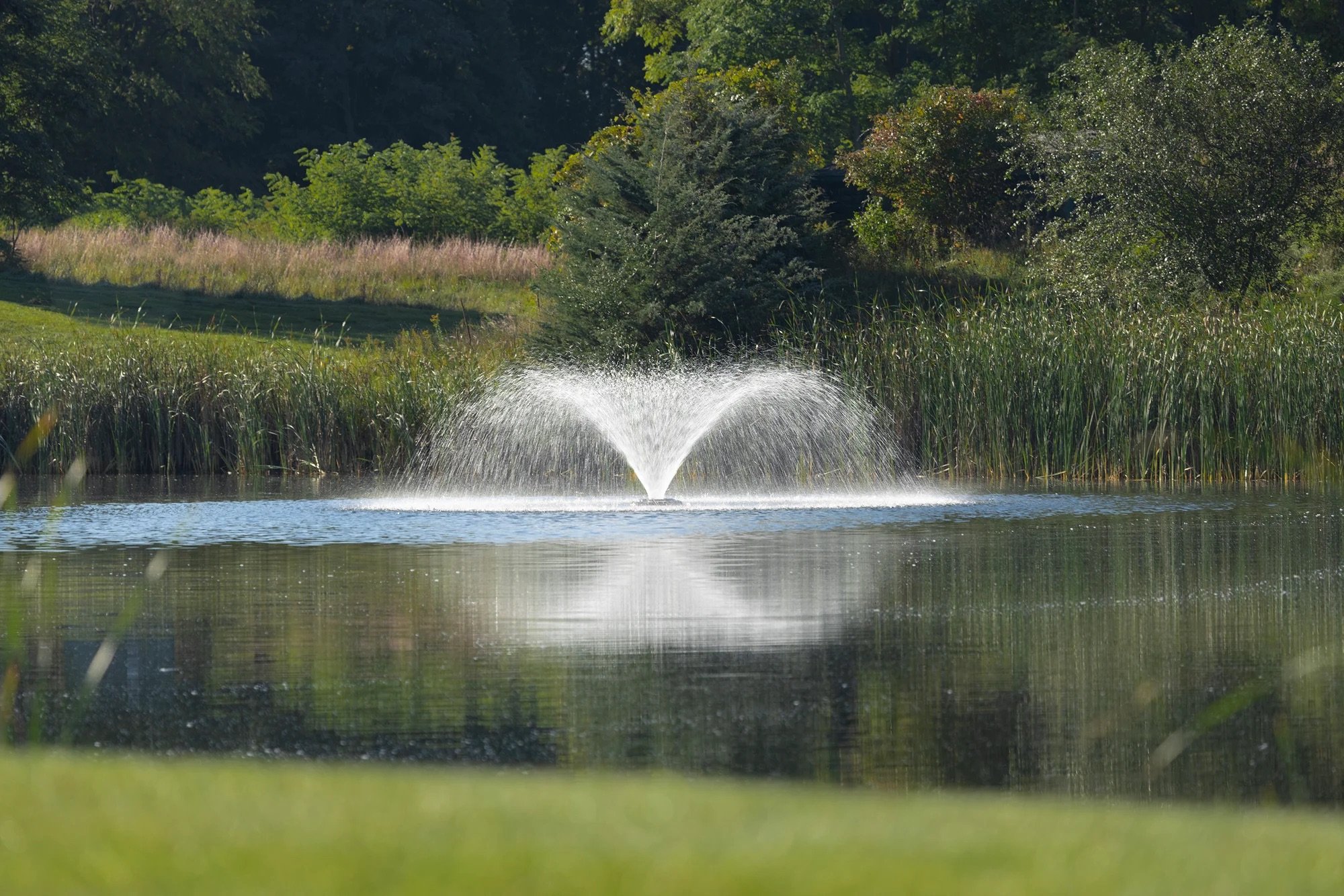Protect turf health, ensure playability, and elevate the aesthetics of your course year-round.
Ponds across golf courses in Massachusetts, Rhode Island, and Connecticut aren’t just picturesque—they’re essential. Whether acting as stormwater basins, irrigation sources, or standout design features, these waterbodies impact everything from turf performance to environmental compliance. But without proper management, they can quickly go from helping your course to hindering it.
At Water & Wetland, we provide
science-driven pond and wetland services designed to relieve the burden on superintendents. Our local team understands the unique challenges of New England’s seasonal fluctuations, storm events, and environmental regulations—and we deliver proven strategies to keep your course in peak condition.
Know Your Course’s Waterbodies: Retention vs. Detention
Golf courses in New England often include both:
• Retention ponds: Permanent ponds that hold water year-round. These often double as irrigation reservoirs and enhance course aesthetics.
• Detention basins: Temporary basins that collect and slowly release stormwater. Though less visible, they’re vital for runoff control and compliance.
Understanding each pond’s role helps determine how best to manage vegetation, erosion, and drainage—while avoiding regulatory issues tied to wetlands and stormwater permits.
When Ponds Do More Than Hold Water
On most courses, ponds serve multiple purposes: water storage, drainage, visual enhancement, and wildlife habitat. But that overlap can quickly lead to problems:
• Sediment buildup clogs irrigation pumps and reduces stormwater capacity.
• Algae blooms degrade water quality and become eyesores.
• Unmanaged vegetation can block outflows or encroach on fairways and greens.
Balancing all these functions takes ongoing effort. Our proactive maintenance helps prevent these issues before they escalate.
Seasonal Inspections: Your First Line of Defense
New England’s weather is unpredictable. Inspections after snowmelt, heavy rains, and late-season leaf fall are critical. These routine checks help identify:
• Eroding banks or collapsing edges
• Blocked inlets and outlets
• Excess debris or invasive vegetation
• Early signs of sediment accumulation
Early intervention keeps ponds functioning properly and avoids the need for costly repairs during your peak season.
Shoreline Erosion Is Preventable—and Worth Addressing
Erosion in pond margins leads to:
• Shallower ponds and reduced capacity
• High nutrient loads (which feed algae)
• Compromised turf along pond edges
Solutions include:
• Bioengineering tools like coir logs for high-traffic areas
• Sediment removal (dredging) when buildup affects function or aesthetics
Control Nutrients, Control Algae
Excess nitrogen and phosphorus from fertilizer overspray, clippings, and geese waste are common in golf settings. These nutrients fuel algae growth, especially during warm, stagnant summer weeks.
Ways to reduce nutrient load include:
• Establishing no-mow buffer zones
• Calibrating fertilizer applications to avoid overspray
• Routine water quality testing
• Installing floating wetland islands to intercept runoff
Aeration: Not Just for Looks
Boosting oxygen levels
• Reducing odors
• Supporting beneficial microbial activity
Surface fountains are great for visual areas, but subsurface diffused aeration is ideal for deep or secluded ponds—especially those used for irrigation.
Vegetation Control: Proactive, Not Reactive
Unchecked aquatic plants can:
• Reduce flow and oxygen levels
• Create unsightly mats and player complaints
• Lead to full-blown infestations
An integrated vegetation management plan may include:
• Early-season assessments
• Mechanical removal or trimming
• Biological options (e.g., sterile grass carp, where allowed)
• Targeted herbicide treatments by licensed professionals
Aligning Pond Care With Course Goals
Golf course operations are already complex—don’t let pond issues add to the stress. Integrating pond and wetland care into your overall maintenance program improves consistency, reduces unexpected expenses, and ensures your course stays compliant with local and federal guidelines.
Our team at Water & Wetland works directly with superintendents to streamline inspections, respond quickly to concerns, and implement maintenance plans that align with your course calendar and budget.
Ready to Take Pond Management Off Your To-Do List?
Let Water & Wetland keep your ponds clean, compliant, and functioning year-round—so you can keep your attention where it belongs: on delivering exceptional turf and a great player experience.
Contact us today to schedule a course consultation or request a pond evaluation.
About Water & Wetland, A Jones Lake Management Partner
Water & Wetland is a trusted expert in lake, pond, and wetland management, providing innovative and environmentally responsible solutions to control invasive species, restore shorelines, and improve water quality. As a Jones Lake Management Partner, we serve HOAs, golf courses, municipalities, and private landowners with customized lake and pond management plans designed to promote long-term ecological health. We understand the importance of proper permitting and regulatory compliance, ensuring that all projects meet local, state, and federal environmental standards. With a commitment to sustainability and science-based practices, Water & Wetland helps clients maintain thriving, well-balanced waterbodies





